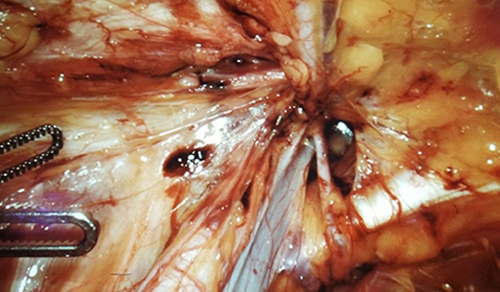Columbia RunLab: Optimizing Performance and Preventing Injury

Dr. Christopher J. Visco and Dr. Colleen M. Brough
There’s more to running than meets the eye, as runners are finding out at Columbia RunLab, a center for biomechanical running analysis at NewYork-Presbyterian/Columbia University Medical Center. The Columbia RunLab offers high-level personalized evaluation and education to runners of all levels and experience to optimize their performance and prevent injury.
“Runners usually come into my office with some kind of joint or muscle pain,” says Christopher J. Visco, MD, Ursula Corning Associate Professor, and Vice Chair of Education in the Department of Rehabilitation and Regenerative Medicine. “At the core of why they’re developing these issues is an abnormality of their biomechanics — the way they run. Whether they have just started running or have been running for a long time, the likelihood of developing an injury increases dramatically if they’ve got poor running biomechanics.”
“Patients today are more interested in pushing the boundaries of what is possible. In many ways it requires the most finely tuned system to do that in terms of both diet and nutrition, as well as the actual body mechanics.” — Dr. Christopher J. Visco
“From the physician’s standpoint, if we correct whatever is going on — whether it be a tendon or a muscle problem — that’s only as good as we can get medically,” adds Dr. Visco. ”We need the other piece, which is training in a way that the runner can actually improve those underlying issues as well. That’s where the Columbia RunLab is an invaluable resource for our patients.”
Dr. Visco cites other critical elements that must be in balance in order to prevent injuries. “We need to know all the pieces to the puzzle. What is their nutrition like? Do they have stressors? We ask about sleep. You can train at a very high level, but if this is accompanied by an appropriate diet, time away from stress, and enough sleep, runners are more likely to remain injury-free.”
Opened in October 2016, Columbia RunLab was developed by its Founder and Director, Colleen M. Brough, PT, DPT, MS, OCS, a board certified orthopedic clinical specialist in physical therapy in the Department of Rehabilitation and Regenerative Medicine at NewYork-Presbyterian/Columbia. An expert in orthopedic physical therapy, sports injury prevention, and screening, Dr. Brough has spent more than 15 years as a physical therapist in the global running community working with elite athletes, as well as novices, and is herself an avid runner.
“We created the RunLab with several goals in mind,” says Dr. Brough. “One is to provide a personalized medicine experience specifically for running athletes who want to improve their performance or who want to manage or prevent an injury. It’s a very intimate and dynamic experience focusing on education and clinical excellence.”

A component of Columbia University’s Doctoral Degree Program of Physical Therapy, the RunLab fosters student development, with doctoral candidates participating in all aspects of the program. “One of our primary goals was to offer our doctoral students a chance to develop their skills in a clinical teaching and learning environment,” says Dr. Brough, who is also an Assistant Professor of Rehabilitation and Regenerative Medicine in Columbia University’s Program in Physical Therapy and Co-Director of Clinical Education.
“We created the RunLab to provide a personalized medicine experience specifically for running athletes who want to improve their performance or who want to manage or prevent an injury.” — Dr. Colleen M. Brough
The Columbia RunLab also works with underprivileged and special needs running groups throughout the community. “We are proud to offer pro bono running analyses to those who use running in a meaningful way, for example, the Wounded Warrior Project,” says Dr. Brough. “Many of our veterans use endurance running to manage PTSD symptoms. The Achilles Group, which offers running coaches to individuals who are severely disabled to help them cross the finish line, is also among the organizations we plan to work with.”
The RunLab Experience
The RunLab uses state-of-the-art technology to collect information about running mechanics, including stride length, step length, cadence, and foot strike. Four runners at a time participate in an analysis session. “In the first half of the program, each runner moves through different examination stations,” says Dr. Brough. “We assess foot and ankle mechanics and examine specific strength and flexibility using the FMS — functional movement screen — made famous by the NFL for preseason screening. We also use 2D video analysis to gather running metrics and spatial temporal parameter data in real time.”
The second half of the program involves a roundtable discussion. “This is where the magic happens,” says Dr. Brough, who along with the doctoral students who conducted the examinations, physicians who may have observed the session, and the four runners gather together to view each runner’s video projected on a large screen.
“The physical therapists describe in real time the mechanics of the participant’s running form and how that relates to the physical exam performed,” says Dr. Brough. “Most importantly, we discuss how this relates in the context of research. What does the literature suggest is relevant?”
Runners have been very engaged, says Dr. Brough. “They’re learning in the moment and also learning about the other runners they’re seeing on video. By the end of the evening everyone has this common language and a good grasp of what the research suggests is important in terms of injury and performance.”
Dr. Brough categorizes runners into two types. “First, the ‘overstriders.’ When their foot first hits the ground we’re looking for the contact angle, how bent the foot is, and if they’re landing relatively foot-flat. How bent is their knee? They also should land like a spring — not stiff as a board. How far forward is that foot from their center of gravity? Are they reaching very far out with their heel, or is their foot landing under their body? If you incorporate these elements into a run you can minimize the impact that the lower extremity experiences. This is significant in the context of injury prevention, but also very important in the context of boney stress injuries.”

Source: Current Concepts in Running Analysis: An Evidence-Led Approach, Colleen M. Brough, PT, DPT, MS, OCS, Columbia RunLab
“As the foot of a ‘medial collapser’ hits the ground and they start to load the limb, we often see a drifting in of the knee toward midline, a drop of the pelvis, or a lean of the trunk,” explains Dr. Brough. “These very specific pathomechanics, namely dynamic knee valgus and pelvic drop, have been linked to injuries and are commonly associated with weakness or poor recruitment of the gluteus maximus, the gluteus medius, and the deep core muscles. Running is a series of standing on one leg and then the other. You never have two feet on the ground at the same time, and when it comes to injury, everything is revealed when the runner loads the leg and moves into mid-stance.”
“In a cohort of runners,” notes Dr. Brough, “you will find high rates of hamstring strain, Achilles tendinitis, plantar fasciitis, hip flexor strain or hip flexor tendinitis, or patella femoral pain syndrome. It doesn’t matter where the actual pain location is. All of these runners seem to have the same common presentation. That’s what we look for when we videotape them.”
“The Columbia RunLab helps to prevent injuries by identifying early on what might predispose runners to developing back, foot, ankle, or knee pain because of their running style.” — Dr. Anna-Christina Bevelaqua
Anna-Christina Bevelaqua, MD, a Columbia physiatrist who specializes in sports medicine, often refers her patients to the RunLab for analysis if they are concerned about their gait or if they have sustained injuries. “I was very excited when Colleen brought this program to Columbia,” says Dr. Bevelaqua. “The RunLab helps to prevent injuries by identifying early on what might predispose runners to developing back, foot, ankle, or knee pain because of their running style.”
Dr. Bevelaqua notes that while many runners are athletic and strong, they often have no gluteal strength or very poor core strength. “Sometimes running doesn’t affect all of the muscles that you need to strengthen to prevent injury,” says Dr. Bevelaqua, who encourages runners to cross-train to build strength in other muscles. “The RunLab is a way to identify those weaknesses early on so that the runner can correct those deficits and, hopefully, have an injury-free running career.”
Related Publications

Research Update: Rehabilitation Robotics in Cerebral Palsy

Affiliations Broaden Residency Training Experience








